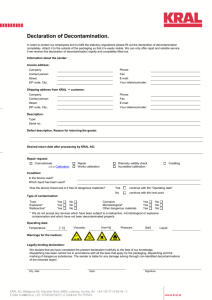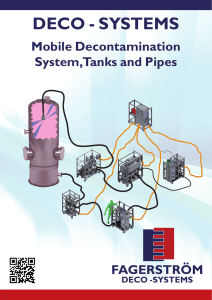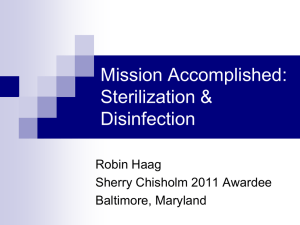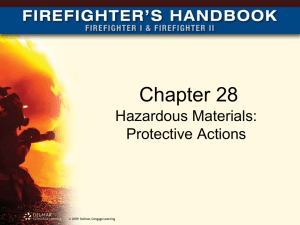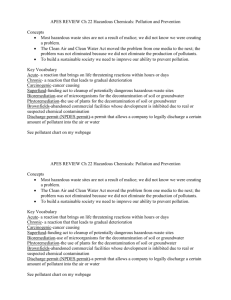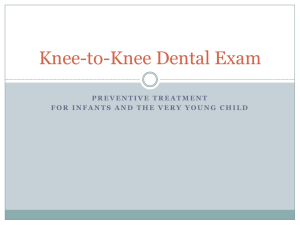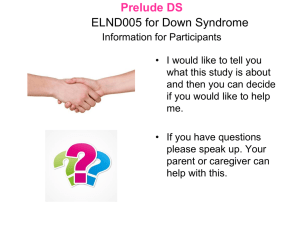Hospital Guidelines for Pediatrics in Disasters
advertisement
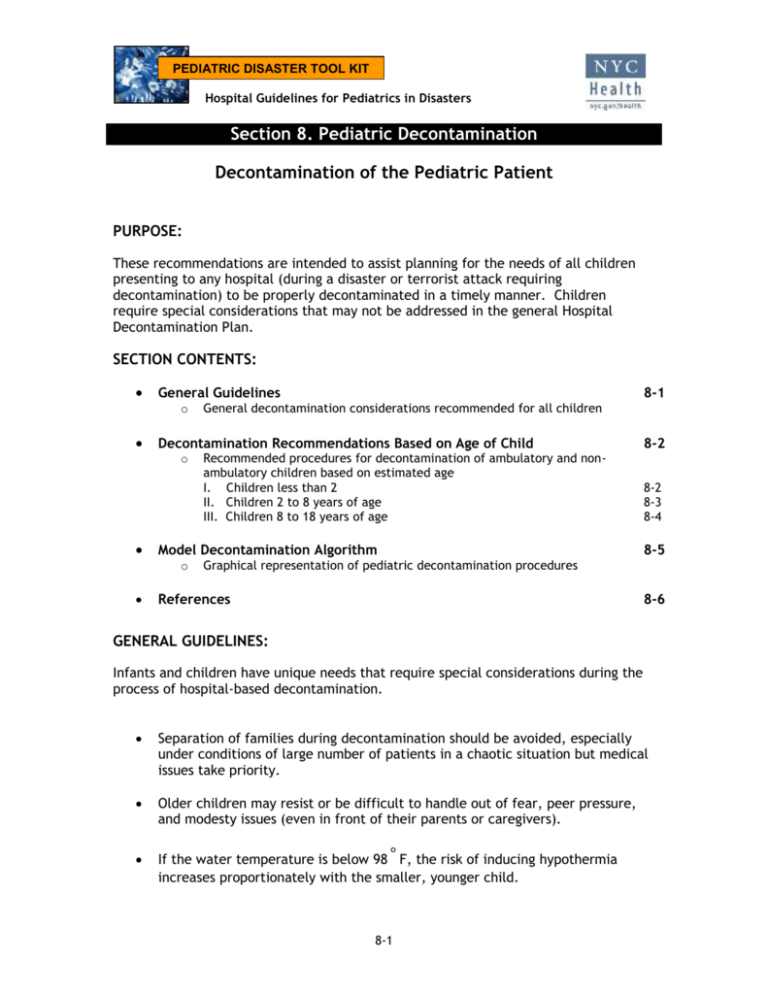
PEDIATRIC DISASTER TOOL KIT Hospital Guidelines for Pediatrics in Disasters Section 8. Pediatric Decontamination Decontamination of the Pediatric Patient PURPOSE: These recommendations are intended to assist planning for the needs of all children presenting to any hospital (during a disaster or terrorist attack requiring decontamination) to be properly decontaminated in a timely manner. Children require special considerations that may not be addressed in the general Hospital Decontamination Plan. SECTION CONTENTS: General Guidelines o Decontamination Recommendations Based on Age of Child o Recommended procedures for decontamination of ambulatory and nonambulatory children based on estimated age I. Children less than 2 II. Children 2 to 8 years of age III. Children 8 to 18 years of age Model Decontamination Algorithm o 8-1 General decontamination considerations recommended for all children 8-2 8-2 8-3 8-4 8-5 Graphical representation of pediatric decontamination procedures References 8-6 GENERAL GUIDELINES: Infants and children have unique needs that require special considerations during the process of hospital-based decontamination. Separation of families during decontamination should be avoided, especially under conditions of large number of patients in a chaotic situation but medical issues take priority. Older children may resist or be difficult to handle out of fear, peer pressure, and modesty issues (even in front of their parents or caregivers). If the water temperature is below 98 F, the risk of inducing hypothermia increases proportionately with the smaller, younger child. ° 8-1 Section 8. Pediatric Decontamination Attention to airway management is a priority throughout decontamination showers. It cannot be assumed that the parents or caregivers will be able to decontaminate both themselves and their children at the same time (“hot zone” personnel should recognize the need to assist them). Large volume, low pressure water delivery systems (e.g. handheld hose sprayers) that are “child friendly” should be incorporated into the hospital decontamination showers. The smaller the child, the bigger the problem regarding any of these considerations such as hypothermia, airway management, separation of families, and ability to effectively decontaminate the child. DECONTAMINATION RECOMMENDATIONS BASED ON AGE OF CHILD: Children are divided into three groups by ages: 8-18 years old (school age), 2-8 years old (pre-school), and 0-2 years old (infants and toddlers). The following recommendations are based on the estimated child’s age, since asking may be impractical due to the limitations of the PPE worn by decontamination team members or to a large influx of patients. The following recommendations are meant as general guidelines. I. Children less than 2 years of age (infants and toddlers): Infants and toddlers represent the most challenging group in which these special needs considerations are the most important. 1. All infants and toddlers should be placed on a stretcher and disrobed by either the child’s caregiver or “hot zone” personnel. All clothes and items that cannot be decontaminated should be placed in appropriate containers or bags as provided by the hospital and labeled. 2. Each child should then be accompanied through the decontamination shower by either the child’s caregiver or “hot zone” personnel to ensure the entire patient is properly decontaminated. It is not recommended that the child be separated from family members or adult caregiver. It is not recommended that the caregiver carry the child due to the possibility of injury resulting from a fall, or from dropping a slippery and squirming child. Special attention must be given to the child’s airway while in the shower. 8-2 Hospital Guidelines for Pediatrics in Disasters 3. Non-ambulatory children will be placed on a stretcher by “hot zone” personnel and disrobed (using trauma shears if necessary). All clothes and items that cannot be decontaminated should be placed in appropriate containers or bags as provided by the hospital and labeled. 4. Each non-ambulatory child should then be escorted through the decontamination shower by either the child’s caregiver or “hot zone” personnel to ensure the entire patient is properly decontaminated. Special attention must be paid to the child’s airway while in the shower. 5. Once through the shower, the child’s caregiver or “cold zone” personnel will be given a towel and sheets to dry off the child, and a hospital gown. Immediately, the child should be given a unique identification number on a wristband and then triaged to an appropriate area for medical evaluation. 6. Children and their families (parents or caregivers) should not be separated unless critical medical issues take priority. II. Children 2 to 8 years of age (pre-school): From age 2 to 8, children should be able to walk and speak, yet will still look like a child with considerable variations in physiology and anatomy. 1. Ambulatory children should be assisted in disrobing by either the child’s caregiver or “hot zone” personnel. All clothes and items that cannot be decontaminated should be placed in appropriate containers or bags as provided by the hospital and labeled. 2. Each child should be directly accompanied through the shower by either the child’s caregiver or “hot zone” personnel to ensure the entire patient is properly decontaminated. It is recommended that the child not be separated from family member(s) or the adult caregiver. 3. Non-ambulatory children should be placed on a stretcher by “hot zone” personnel and disrobed (using trauma shears if necessary). All clothes and items that cannot be decontaminated should be placed in appropriate containers or bags as provided by the hospital and labeled. 4. Each non-ambulatory child on a stretcher is escorted through the decontamination shower and assisted with decontamination to ensure the entire patient is properly decontaminated. 5. Once through the shower, each child should be given a towel and sheets to dry, and a hospital gown. Immediately, the child should be given a unique identification number on a wristband and then triaged to an appropriate area for medical evaluation. 8-3 Section 8. Pediatric Decontamination 6. Children and their families (parents or caregivers) should not be separated unless critical medical issues take priority. III. Children 8 to 18 years of age (school age): At the age of 8 years and upward, the airway anatomy approximates that of an adult. Although it is tempting to regard this age group as “small adults” – there are special needs unique to this age group. 1. Ambulatory children should disrobe when instructed to do so by “hot zone” personnel. All clothes and items that cannot be decontaminated should be placed in appropriate containers or bags as provided by the hospital and labeled. 2. Each child should then walk through the decontamination shower, preferably in succession with their parent or caregiver, and essentially decontaminate him/herself. 3. Non-ambulatory children should be placed on a stretcher by “hot zone” personnel and disrobed (using trauma shears if necessary). All clothes and items that cannot be decontaminated should be placed in appropriate containers or bags as provided by the hospital and labeled. 4. Then each non-ambulatory child is escorted through the decontamination shower and assisted with decontamination to ensure the entire patient is properly decontaminated. 5. Once through the shower, each child will be given a towel and sheets to dry, and a hospital gown. Immediately, the child should be given a unique identification number on a wristband and then triaged to an appropriate area for medical evaluation. 6. Children and their families (parents or caregivers) should not be separated unless critical medical issues take priority. 8-4 Hospital Guidelines for Pediatrics in Disasters Hospital Decontamination and the Pediatric Patient MODEL PROTOCOL ALGORITHM Victims arrive at the hospital requiring decontamination. Children are present among the victims. Critical injuries are decontaminated first. Children and their families (parents or caregivers) should not be separated unless critical medical issues take priority Non-ambulatory Ambulatory Estimate child’s age by visual inspection disrobe by child’s caregiver and “hot zone” personnel place on a stretcher or restraining device escort through the decon shower by “hot zone” personnel and caregiver direct supervision of decon (of caregiver, too) monitor airway Preschool (2 to 8 yrs old) School Age (8 to 18 yrs old) disrobe w/o assistance respect modesty respect privacy child decons him/herself, but goes through decon shower in succession with caregiver, parent, or classmates assist disrobing (child’s caregiver or “hot zone” personnel) direct supervision of decon monitor airway escort through the shower by either caregiver or “hot zone” personnel Infants and Toddlers ( < 2 yrs old) disrobe by child’s caregiver and “hot zone” personnel place on a stretcher or restraining device escort through the decon shower by “hot zone” personnel and caregiver direct supervision of decon (of caregiver, too) monitor airway (Caregiver should not carry the child due to the risk of accidental trauma resulting from a fall or from dropping the child while in the shower.) Treat or prevent hypothermia (towels, gowns, warming blankets) Immediately give a unique identification number on a wristband (or equivalent) Triage to an appropriate area for further medical evaluation 8-5 Please note: Children and their families (parents or caregivers) should not be separated unless critical medical issues take priority Section 8. Pediatric Decontamination REFERENCES 1) Occupational Safety and Health Administration (OSHA), 29 CFR 1910.120, Hazardous Materials Incident Response Curriculum Guidelines (HAZWOPER), last updated Directive 11/05/2003. http://www.oshaslc.gov/pls/oshaweb/owadisp.show_document?p_table=STANDARDS&p_id=9765 2) OSHA Best Practices for Hospital-based First Receivers of Victims from Mass Casualty Incidents Involving the Release of Hazardous Substances, December 2004. http://www.osha.gov/dts/osta/bestpractices/firstreceivers_hospital.html 3) U.S. Department of Health and Human Services: Concept of Operations Plan (CONOPS) for Public Health and Medical Emergencies, March 2004, Tommy G. Thompson, Secretary Dept. HHS. http://www.dhhs.gov/nvpo/pandemicplan/hhs_conops.pdf 4) Okumura T, Takasu N, Ishimatsu S, Miyanoki S, Mitsuhashi A, Kumada K, Tanaka K, Hinohara S. Report on 640 victims of the Tokyo subway sarin attack. Ann Emerg Med 1996 Aug;28(2):129-35 5) MacIntyre AG, Christopher GW, Eitsen E, Gum R, Weir S, DeAtley C, Tonat K, Barbera JA. Weapons of mass destruction events with contaminated casualties. JAMA 2000; 283:242-249. 6) Barbera JA, MacIntyre AG. Mass Casualty Handbook: Hospital, Emergency Preparedness and Response, First edition 2003: Jane’s Information Group, Ltd. 7) Hick JL, Hanfling D, Burnstein J, Markham A, McIntyre G, and Barbera JA. Protective equipment for health care facility decontamination personnel: regulations, risks, and recommendations. Ann Emerg Med Sept 2003; 42(3):370-380 8) Hick JL, Penn P, Hanfling D, Lapp MA, O’Laughlin D, Burnstein JL. Establishing and training health care facility decontamination teams. Ann Emerg Med 2003 Sept; 42(3):381-390 9) Markenson D. Redlener I. Pediatric Preparedness for Disasters and Terrorism: A National Consensus Conference. Executive Summary 2003. National Center for Disaster Preparedness. Columbia University, Mailman School of Public Health http://www.bt.cdc.gov/children/pdf/working/execsumm03.pdf 10) Testimony before the Senate Committee on Health, Education, Labor, and Pensions Subcommittee on Children and Families Presented by Joseph L. Wright, MD, MPH, FAAP on Behalf of the American Academy of Pediatrics. Senate Committee on Health, Education, Labor, and Pensions Subcommittee on Children and Families. Washington, DC: American Academy of Pediatrics, 2001 of the United States Senate http://www.aap.org/terrorism/resources/academy_resources.html 8-6


